check oil MERCEDES-BENZ ML SUV 2008 Owners Manual
[x] Cancel search | Manufacturer: MERCEDES-BENZ, Model Year: 2008, Model line: ML SUV, Model: MERCEDES-BENZ ML SUV 2008Pages: 381, PDF Size: 7.18 MB
Page 10 of 381
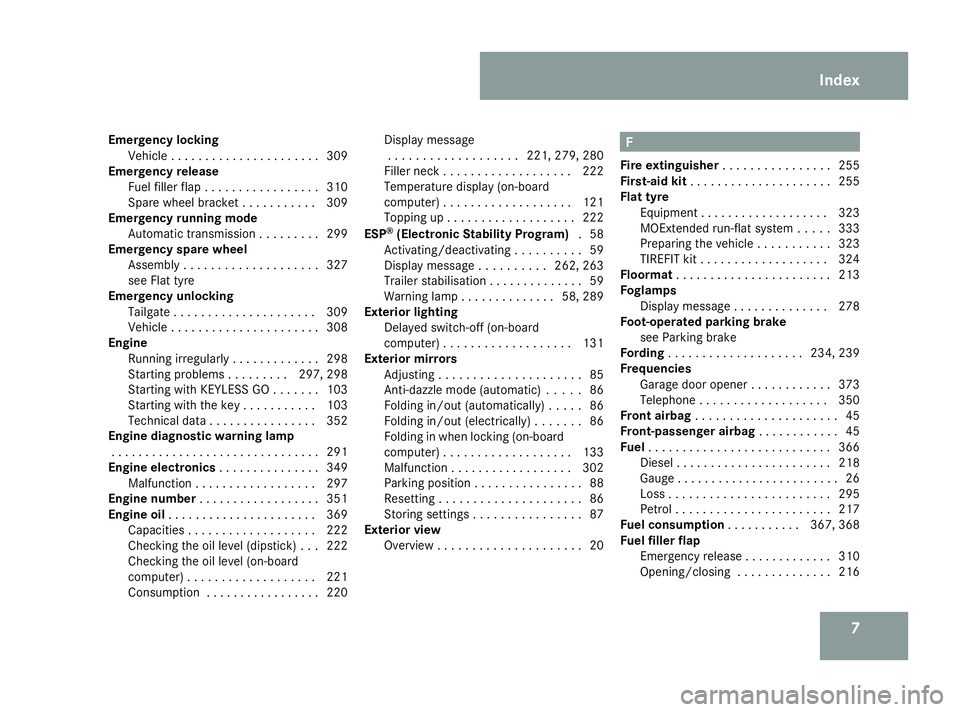
7
Emergency locking
Vehicle . . . . . . . . . . . . . . . . . . . . . .309
Emergency release
Fuel filler fla p.. . . . . . . . . . . . . . . .310
Spare wheel bracket . . . . . . . . . . .309
Emergency running mode
Automatic transmission . . . . . . . . .299
Emergency spare wheel
Assembl y.. . . . . . . . . . . . . . . . . . .327
see Flat tyre
Emergency unlocking
Tailgate . . . . . . . . . . . . . . . . . . . . .309
Vehicle . . . . . . . . . . . . . . . . . . . . . .308
Engine
Running irregularl y.. . . . . . . . . . . .298
Starting problems . . . . . . . . .297, 298
Starting with KEYLESS GO . . . . . . .103
Starting with the key . . . . . . . . . . .103
Technical data . . . . . . . . . . . . . . . .352
Engine diagnostic warning lamp
. . . . . . . . . . . . . . . . . . . . . . . . . . . . . . .291
Engine electronics . . . . . . . . . . . . . ..349
Malfunction . . . . . . . . . . . . . . . . . .297
Engine number . . . . . . . . . . . . . . . . . .351
Engine oil . . . . . . . . . . . . . . . . . . . . . .369
Capacities . . . . . . . . . . . . . . . . . . .222
Checking the oil level (dipstick) . . .222
Checking the oil level (on-board
computer) . . . . . . . . . . . . . . . . . . .221
Consumption . . . . . . . . . . . . . . . . .220 Display message
. . . . . . . . . . . . . . . . . . .221, 279, 280
Filler neck . . . . . . . . . . . . . . . . . . .222
Temperature display (on-board
computer) . . . . . . . . . . . . . . . . . . .121
Topping up . . . . . . . . . . . . . . . . . . .222
ESP ®
(Electronic Stability Program) .58
Activating/deactivating . . . . . . . . . .59
Display message . . . . . . . . . .262, 263
Trailer stabilisatio n.. . . . . . . . . . . . .59
Warning lamp . . . . . . . . . . . . . .58, 289
Exterior lighting
Delayed switch-off (on-board
computer) . . . . . . . . . . . . . . . . . . .131
Exterior mirrors
Adjusting . . . . . . . . . . . . . . . . . . . . .85
Anti-dazzle mode (automatic) . . . . .86
Folding in/out (automatically ).. . . .86
Folding in/out (electrically) . . . . . . .86
Folding in when locking (on-board
computer) . . . . . . . . . . . . . . . . . . .133
Malfunction . . . . . . . . . . . . . . . . . .302
Parking position . . . . . . . . . . . . . . . .88
Resettin g.. . . . . . . . . . . . . . . . . . . .86
Storing settings . . . . . . . . . . . . . . . .87
Exterior view
Overview . . . . . . . . . . . . . . . . . . . . .20 F
Fire extinguisher . . . . . . . . . . . . . . . .255
First-aid kit . . . . . . . . . . . . . . . . . . . . .255
Flat tyre Equipment . . . . . . . . . . . . . . . . . . .323
MOExtended run-flat system . . . . .333
Preparing the vehicle . . . . . . . . . . .323
TIREFIT kit . . . . . . . . . . . . . . . . . . .324
Floormat . . . . . . . . . . . . . . . . . . . . . . .213
Foglamps Display message . . . . . . . . . . . . . .278
Foot-operated parking brake
see Parking brake
Fording . . . . . . . . . . . . . . . . . . . .234, 239
Frequencies Garage door opener . . . . . . . . . . . .373
Telephone . . . . . . . . . . . . . . . . . . .350
Front airbag . . . . . . . . . . . . . . . . . . . . .45
Front-passenger airbag . . . . . . . . . . ..45
Fuel . . . . . . . . . . . . . . . . . . . . . . . . . . .366
Diese l.. . . . . . . . . . . . . . . . . . . . . .218
Gauge . . . . . . . . . . . . . . . . . . . . . . . .26
Loss . . . . . . . . . . . . . . . . . . . . . . . .295
Petrol . . . . . . . . . . . . . . . . . . . . . . .217
Fuel consumption . . . . . . . . . ..367, 368
Fuel filler flap Emergency release . . . . . . . . . . . . .310
Opening/closing . . . . . . . . . . . . . .216 Index
164_AKB; 5; 5, en-GB
wobuchh,
Version: 2.10.6 2008-05-11T11:55:12+02:00 - Seite 7Dateiname: 6515_4293_02_buchblock.pdf; preflight
Page 14 of 381
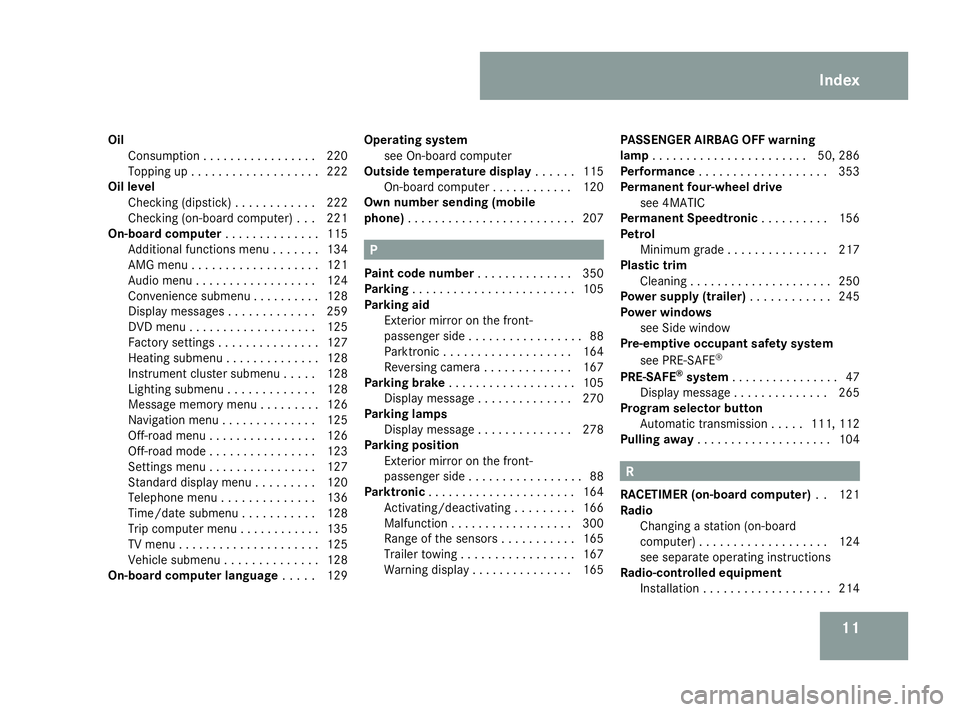
11
Oil
Consumption . . . . . . . . . . . . . . . . .220
Topping up . . . . . . . . . . . . . . . . . . .222
Oil level
Checking (dipstick) . . . . . . . . . . . .222
Checking (on-board computer) . . .221
On-board computer . . . . . . . . . . . . ..115
Additional functions menu . . . . . . .134
AMG menu . . . . . . . . . . . . . . . . . . .121
Audio menu . . . . . . . . . . . . . . . . . .124
Convenience submenu . . . . . . . . . .128
Display messages . . . . . . . . . . . . .259
DVD menu . . . . . . . . . . . . . . . . . . .125
Factory settings . . . . . . . . . . . . . . .127
Heating submenu . . . . . . . . . . . . . .128
Instrument cluster submenu . . . . .128
Lighting submenu . . . . . . . . . . . . .128
Message memory menu . . . . . . . . .126
Navigation menu . . . . . . . . . . . . . .125
Off-road menu . . . . . . . . . . . . . . . .126
Off-road mode . . . . . . . . . . . . . . . .123
Settings menu . . . . . . . . . . . . . . . .127
Standard display menu . . . . . . . . .120
Telephone menu . . . . . . . . . . . . . .136
Time/date submenu . . . . . . . . . . .128
Trip computer menu . . . . . . . . . . . .135
TV menu . . . . . . . . . . . . . . . . . . . . .125
Vehicle submenu . . . . . . . . . . . . . .128
On-board computer language . . . ..129 Operating system
see On-board computer
Outside temperature display . . . . ..115
On-board computer . . . . . . . . . . . .120
Own number sending (mobile
phone) . . . . . . . . . . . . . . . . . . . . . . . . .207 P
Paint code number . . . . . . . . . . . . ..350
Parking . . . . . . . . . . . . . . . . . . . . . . . .105
Parking aid Exterior mirror on the front-
passenger sid e.. . . . . . . . . . . . . . . .88
Parktronic . . . . . . . . . . . . . . . . . . .164
Reversing camera . . . . . . . . . . . . .167
Parking brake . . . . . . . . . . . . . . . . . . .105
Display message . . . . . . . . . . . . . .270
Parking lamps
Display message . . . . . . . . . . . . . .278
Parking position
Exterior mirror on the front-
passenger sid e.. . . . . . . . . . . . . . . .88
Parktronic . . . . . . . . . . . . . . . . . . . . . .164
Activating/deactivating . . . . . . . . .166
Malfunction . . . . . . . . . . . . . . . . . .300
Range of the sensors . . . . . . . . . . .165
Trailer towing . . . . . . . . . . . . . . . . .167
Warning display . . . . . . . . . . . . . . .165 PASSENGER AIRBAG OFF warning
lamp
. . . . . . . . . . . . . . . . . . . . . . .50, 286
Performance . . . . . . . . . . . . . . . . . . .353
Permanent four-wheel drive see 4MATIC
Permanent Speedtronic . . . . . . . . ..156
Petrol Minimum grad e.. . . . . . . . . . . . . .217
Plastic trim
Cleaning . . . . . . . . . . . . . . . . . . . . .250
Power supply (trailer) . . . . . . . . . . ..245
Power windows see Side window
Pre-emptive occupant safety system
see PRE-SAFE ®
PRE-SAFE ®
system . . . . . . . . . . . . . . . .47
Display message . . . . . . . . . . . . . .265
Program selector button
Automatic transmission . . . . .111, 112
Pulling away . . . . . . . . . . . . . . . . . . . .104 R
RACETIMER (on-board computer) ..1 21
Radio Changing a station (on-board
computer) . . . . . . . . . . . . . . . . . . .124
see separate operating instructions
Radio-controlled equipment
Installatio n.. . . . . . . . . . . . . . . . . .214 Index
164_AKB; 5; 5, en-GB
wobuchh,
Version: 2.10.6 2008-05-11T11:55:12+02:00 - Seite 11Dateiname: 6515_4293_02_buchblock.pdf; preflight
Page 122 of 381
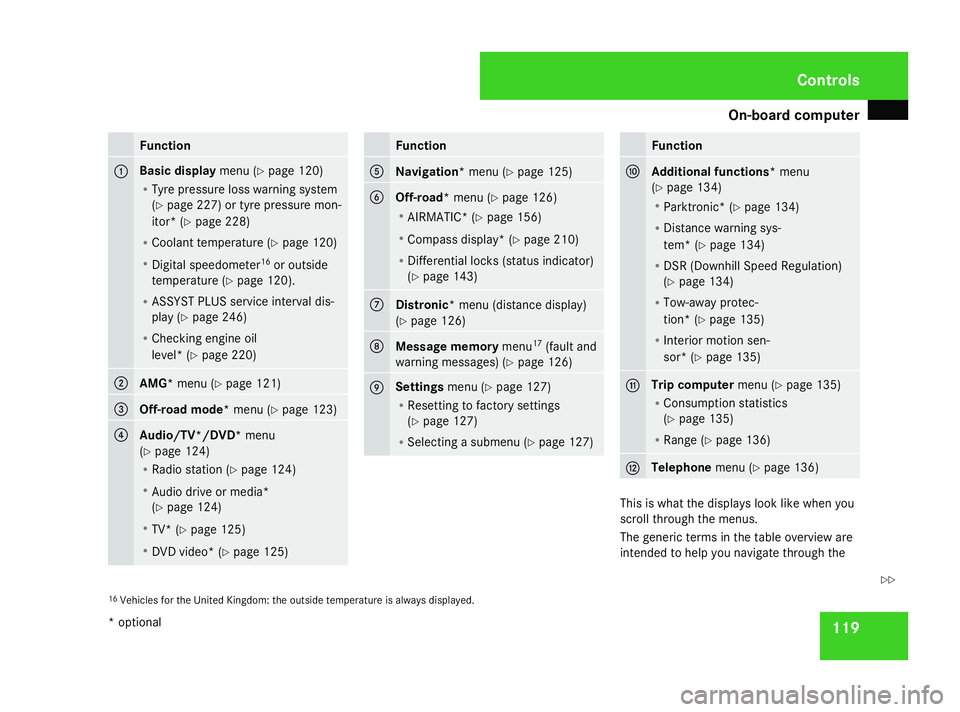
On-board computer
119Function
1 Basic display
menu (Ypage 120)
R Tyre pressure loss warning system
(Y page 227) or tyre pressure mon-
itor* (Y page 228)
R Coolant temperature (Y page 120)
R Digital speedometer 16
or outside
temperature (Y page 120).
R ASSYST PLUS service interval dis-
play (Y page 246)
R Checking engine oil
level* (Y page 220) 2
AMG*
menu (Y page 121) 3
Off-road mode*
menu (Ypage 123) 4
Audio/TV*/DVD*
menu
(Y page 124)
R Radio station ( Ypage 124)
R Audio drive or media*
(Y page 124)
R TV* (Y page 125)
R DVD video* (Y page 125) Function
5
Navigation*
menu (Ypage 125) 6
Off-road*
menu (Ypage 126)
R AIRMATIC* (Y page 156)
R Compass display* ( Ypage 210)
R Differential locks (status indicator)
(Y page 143) 7
Distronic
* menu (distance display)
(Y page 126) 8
Message memory
menu17
(fault and
warning messages) (Y page 126) 9 Settings
menu (Ypage 127)
R Resetting to factory settings
(Y page 127)
R Selecting a submenu (Y page 127) Function
a
Additional functions*
menu
(Y page 134)
R Parktronic* (Y page 134)
R Distance warning sys-
tem* (Y page 134)
R DSR (Downhill Speed Regulation)
(Y page 134)
R Tow-away protec-
tion* (Y page 135)
R Interior motion sen-
sor* (Y page 135) b Trip computer
menu (Ypage 135)
R Consumption statistics
(Y page 135)
R Range (Y page 136) c Telephone
menu (Ypage 136) This is what the displays look like when you
scroll through the menus.
The generic terms in the table overview are
intended to help you navigate through the
16 Vehicles for the United Kingdom: the outside temperature is always displayed. Controls
* optional
164_AKB; 5; 5, en-GB
wobuchh,
Version: 2.10.6 2008-05-11T11:55:12+02:00 - Seite 119 ZDateiname: 6515_4293_02_buchblock.pdf; preflight
Page 223 of 381
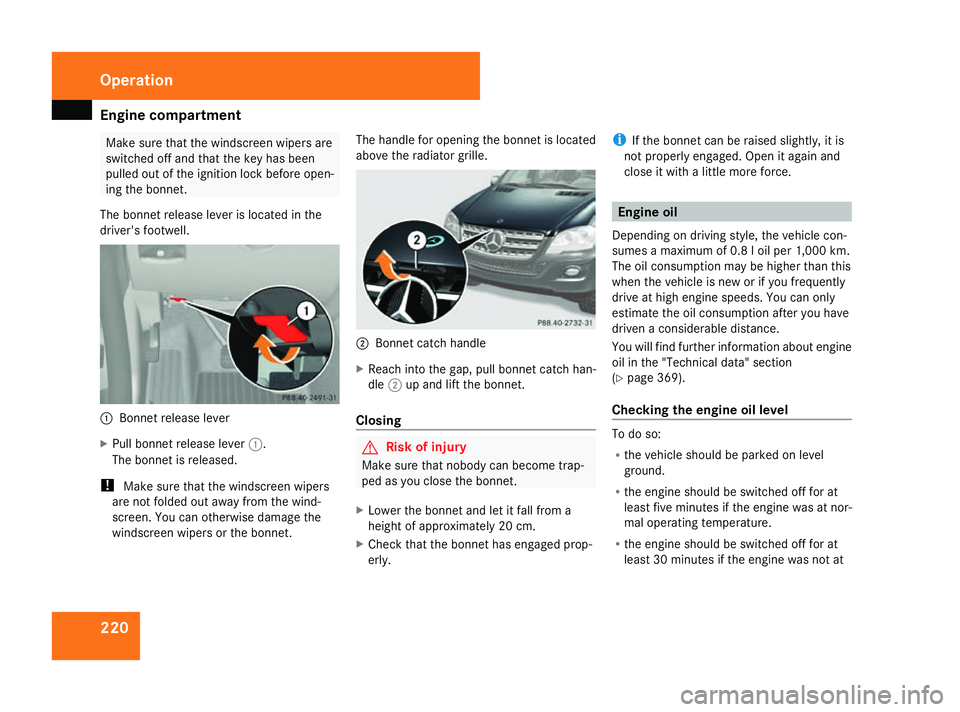
Engine compartment
220 Make sure that the windscreen wipers are
switched off and that the key has been
pulled out of the ignition lock before open-
ing the bonnet.
The bonnet release lever is located in the
driver's footwell. 1
Bonnet release lever
X Pull bonnet release lever 1.
The bonnet is released.
! Make sure that the windscreen wipers
are not folded out away from the wind-
screen. You can otherwise damage the
windscreen wipers or the bonnet. The handle for opening the bonnet is located
above the radiator grille.
2
Bonnet catch handle
X Reach into the gap, pull bonnet catch han-
dle 2up and lift the bonnet.
Closing G
Risk of injury
Make sure that nobody can become trap-
ped as you close the bonnet.
X Lower the bonnet and let it fall from a
height of approximately 20 cm.
X Check that the bonnet has engaged prop-
erly. i
If the bonnet can be raised slightly, it is
not properly engaged. Open it again and
close it with a little more force. Engine oil
Depending on driving style, the vehicle con-
sumes a maximum of 0.8 l oil per 1,000 km.
The oil consumption may be higher than this
when the vehicle is new or if you frequently
drive at high engine speeds. You can only
estimate the oil consumption after you have
driven a considerable distance.
You will find further information about engine
oil in the "Technical data" section
(Y page 369).
Checking the engine oil level To do so:
R
the vehicle should be parked on level
ground.
R the engine should be switched off for at
least five minutes if the engine was at nor-
mal operating temperature.
R the engine should be switched off for at
least 30 minutes if the engine was not at Operation
164_AKB; 5; 5, en-GB
wobuchh,
Version: 2.10.6 2008-05-11T11:55:12+02:00 - Seite 220Dateiname: 6515_4293_02_buchblock.pdf; preflight
Page 224 of 381
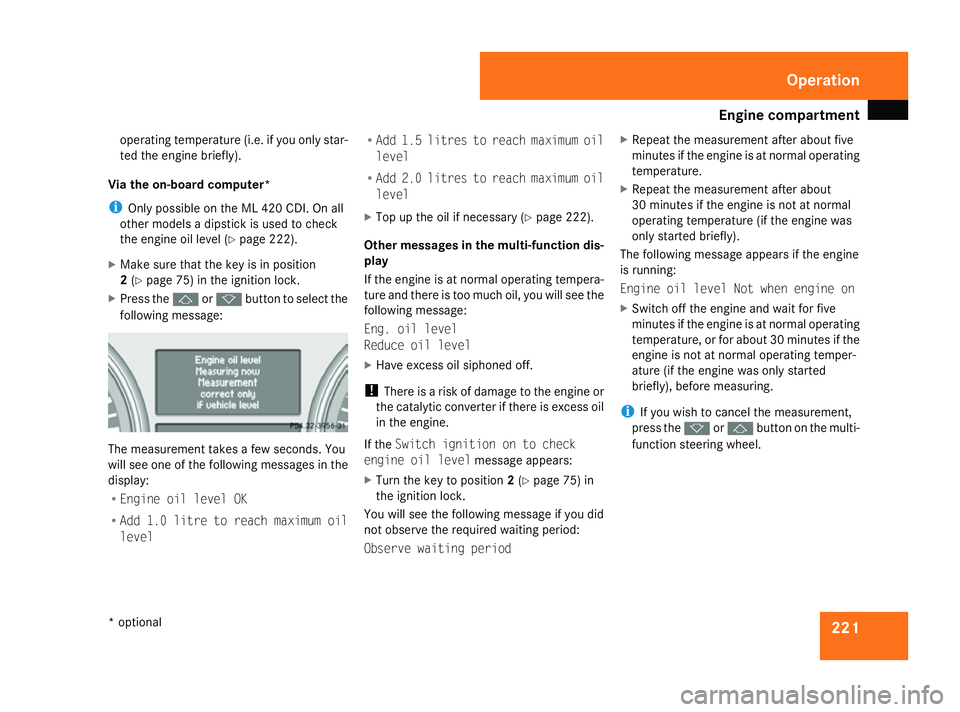
Engine compartment
221
operating temperature (i.e. if you only star-
ted the engine briefly).
Via the on-board computer*
i Only possible on the ML 420 CDI. On all
other models a dipstick is used to check
the engine oil level (Y page 222).
X Make sure that the key is in position
2(Y page 75) in the ignition lock.
X Press the jork button to select the
following message: The measurement takes a few seconds. You
will see one of the following messages in the
display:
R
Engine oil level OK
R Add 1.0 litre to reach maximum oil
level R
Add 1.5 litres to reach maximum oil
level
R Add 2.0 litres to reach maximum oil
level
X Top up the oil if necessary ( Ypage 222).
Other messages in the multi-function dis-
play
If the engine is at normal operating tempera-
ture and there is too much oil, you will see the
following message:
Eng. oil level
Reduce oil level
X Have excess oil siphoned off.
! There is a risk of damage to the engine or
the catalytic converter if there is excess oil
in the engine.
If the Switch ignition on to check
engine oil level message appears:
X Turn the key to position 2(Y page 75) in
the ignition lock.
You will see the following message if you did
not observe the required waiting period:
Observe waiting period X
Repeat the measurement after about five
minutes if the engine is at normal operating
temperature.
X Repeat the measurement after about
30 minutes if the engine is not at normal
operating temperature (if the engine was
only started briefly).
The following message appears if the engine
is running:
Engine oil level Not when engine on
X Switch off the engine and wait for five
minutes if the engine is at normal operating
temperature, or for about 30 minutes if the
engine is not at normal operating temper-
ature (if the engine was only started
briefly), before measuring.
i If you wish to cancel the measurement,
press the korj button on the multi-
function steering wheel. Operation
* optional
164_AKB; 5; 5, en-GB
wobuchh,
Version: 2.10.6 2008-05-11T11:55:12+02:00 - Seite 221 ZDateiname: 6515_4293_02_buchblock.pdf; preflight
Page 228 of 381
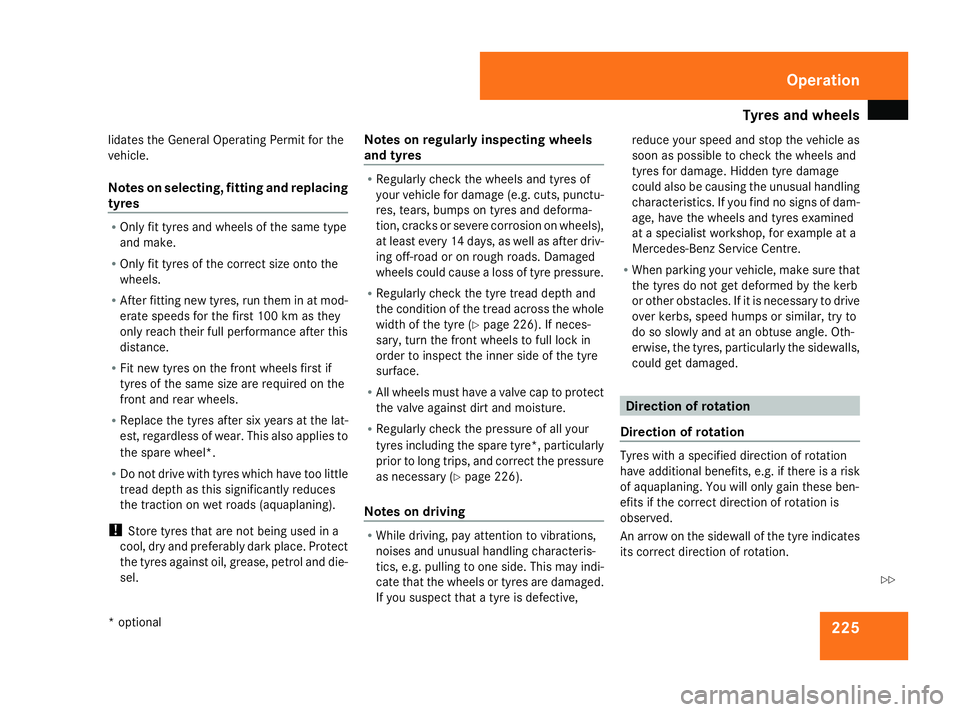
Tyres and wheels
225
lidates the General Operating Permit for the
vehicle.
Notes on selecting, fitting and replacing
tyres
R
Only fit tyres and wheels of the same type
and make.
R Only fit tyres of the correct size onto the
wheels.
R After fitting new tyres, run them in at mod-
erate speeds for the first 100 km as they
only reach their full performance after this
distance.
R Fit new tyres on the front wheels first if
tyres of the same size are required on the
front and rear wheels.
R Replace the tyres after six years at the lat-
est, regardless of wear. This also applies to
the spare wheel*.
R Do not drive with tyres which have too little
tread depth as this significantly reduces
the traction on wet roads (aquaplaning).
! Store tyres that are not being used in a
cool, dry and preferably dark place. Protect
the tyres against oil, grease, petrol and die-
sel. Notes on regularly inspecting wheels
and tyres R
Regularly check the wheels and tyres of
your vehicle for damage (e.g. cuts, punctu-
res, tears, bumps on tyres and deforma-
tion, cracks or severe corrosion on wheels),
at least every 14 days, as well as after driv-
ing off-road or on rough roads. Damaged
wheels could cause a loss of tyre pressure.
R Regularly check the tyre tread depth and
the condition of the tread across the whole
width of the tyre (Y page 226). If neces-
sary, turn the front wheels to full lock in
order to inspect the inner side of the tyre
surface.
R All wheels must have a valve cap to protect
the valve against dirt and moisture.
R Regularly check the pressure of all your
tyres including the spare tyre*, particularly
prior to long trips, and correct the pressure
as necessary (Y page 226).
Notes on driving R
While driving, pay attention to vibrations,
noises and unusual handling characteris-
tics, e.g. pulling to one side. This may indi-
cate that the wheels or tyres are damaged.
If you suspect that a tyre is defective, reduce your speed and stop the vehicle as
soon as possible to check the wheels and
tyres for damage. Hidden tyre damage
could also be causing the unusual handling
characteristics. If you find no signs of dam-
age, have the wheels and tyres examined
at a specialist workshop, for example at a
Mercedes-Benz Service Centre.
R When parking your vehicle, make sure that
the tyres do not get deformed by the kerb
or other obstacles. If it is necessary to drive
over kerbs, speed humps or similar, try to
do so slowly and at an obtuse angle. Oth-
erwise, the tyres, particularly the sidewalls,
could get damaged. Direction of rotation
Direction of rotation Tyres with a specified direction of rotation
have additional benefits, e.g. if there is a risk
of aquaplaning. You will only gain these ben-
efits if the correct direction of rotation is
observed.
An arrow on the sidewall of the tyre indicates
its correct direction of rotation. Operation
* optional
164_AKB; 5; 5, en-GB
wobuchh
,V ersion: 2.10.6
2008-05-11T11:55:12+02:00 - Seite 225 ZDateiname: 6515_4293_02_buchblock.pdf; preflight
Page 239 of 381
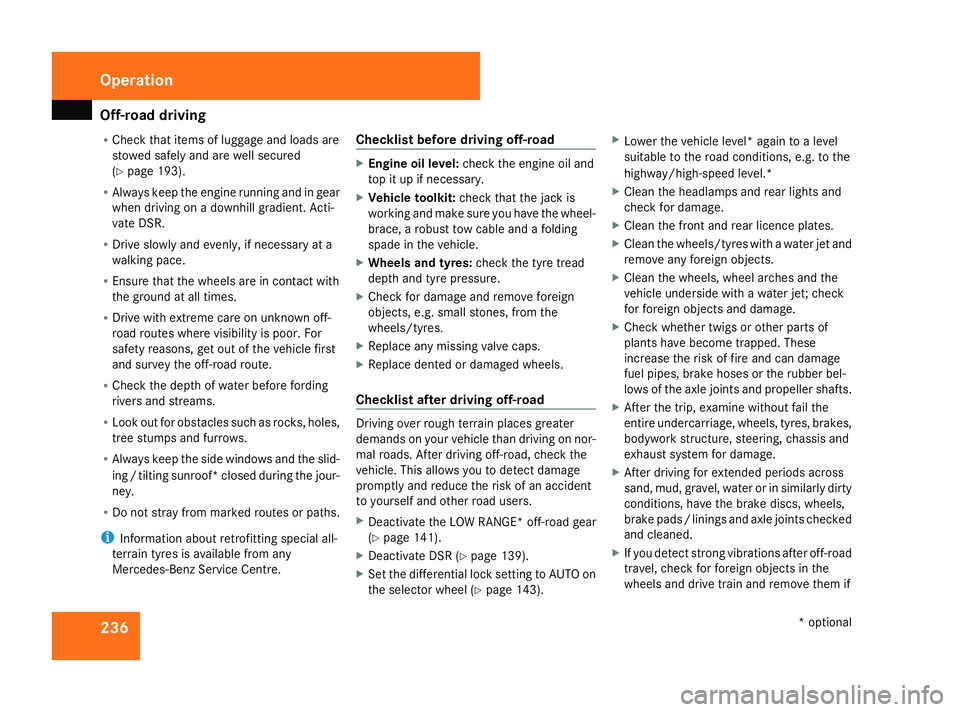
Off-road driving
236
R
Check that items of luggage and loads are
stowed safely and are well secured
(Y page 193).
R Always keep the engine running and in gear
when driving on a downhill gradient. Acti-
vate DSR.
R Drive slowly and evenly, if necessary at a
walking pace.
R Ensure that the wheels are in contact with
the ground at all times.
R Drive with extreme care on unknown off-
road routes where visibility is poor. For
safety reasons, get out of the vehicle first
and survey the off-road route.
R Check the depth of water before fording
rivers and streams.
R Look out for obstacles such as rocks, holes,
tree stumps and furrows.
R Always keep the side windows and the slid-
ing /tilting sunroof* closed during the jour-
ney.
R Do not stray from marked routes or paths.
i Information about retrofitting special all-
terrain tyres is available from any
Mercedes-Benz Service Centre. Checklist before driving off-road X
Engine oil level: check the engine oil and
top it up if necessary.
X Vehicle toolkit: check that the jack is
working and make sure you have the wheel-
brace, a robust tow cable and a folding
spade in the vehicle.
X Wheels and tyres: check the tyre tread
depth and tyre pressure.
X Check for damage and remove foreign
objects, e.g. small stones, from the
wheels/tyres.
X Replace any missing valve caps.
X Replace dented or damaged wheels.
Checklist after driving off-road Driving over rough terrain places greater
demands on your vehicle than driving on nor-
mal roads. After driving off-road, check the
vehicle. This allows you to detect damage
promptly and reduce the risk of an accident
to yourself and other road users.
X
Deactivate the LOW RANGE* off-road gear
(Y page 141).
X Deactivate DSR (Y page 139).
X Set the differential lock setting to AUTO on
the selector wheel (Y page 143). X
Lower the vehicle level* again to a level
suitable to the road conditions, e.g. to the
highway/high-speed level.*
X Clean the headlamps and rear lights and
check for damage.
X Clean the front and rear licence plates.
X Clean the wheels/tyres with a water jet and
remove any foreign objects.
X Clean the wheels, wheel arches and the
vehicle underside with a water jet; check
for foreign objects and damage.
X Check whether twigs or other parts of
plants have become trapped. These
increase the risk of fire and can damage
fuel pipes, brake hoses or the rubber bel-
lows of the axle joints and propeller shafts.
X After the trip, examine without fail the
entire undercarriage, wheels, tyres, brakes,
bodywork structure, steering, chassis and
exhaust system for damage.
X After driving for extended periods across
sand, mud, gravel, water or in similarly dirty
conditions, have the brake discs, wheels,
brake pads /linings and axle joints checked
and cleaned.
X If you detect strong vibrations after off-road
travel, check for foreign objects in the
wheels and drive train and remove them if Operation
* optional
164_AKB; 5; 5, en-GB
wobuchh,
Version: 2.10.6 2008-05-11T11:55:12+02:00 - Seite 236Dateiname: 6515_4293_02_buchblock.pdf; preflight
Page 255 of 381
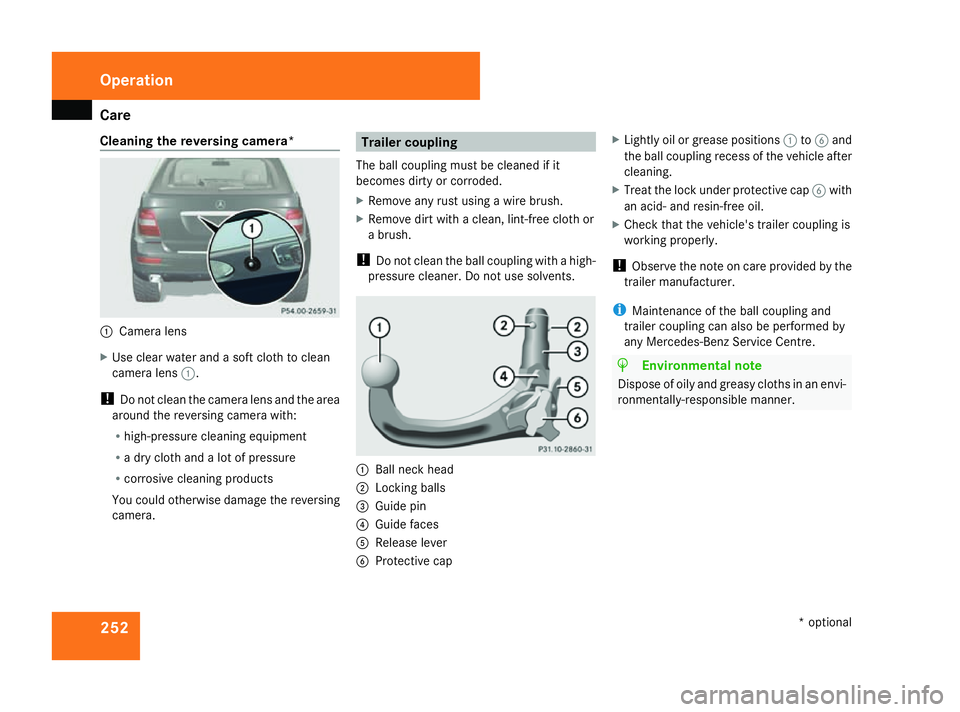
Care
252
Cleaning the reversing camera*
1
Camera lens
X Use clear water and a soft cloth to clean
camera lens 1.
! Do not clean the camera lens and the area
around the reversing camera with:
R high-pressure cleaning equipment
R a dry cloth and a lot of pressure
R corrosive cleaning products
You could otherwise damage the reversing
camera. Trailer coupling
The ball coupling must be cleaned if it
becomes dirty or corroded.
X Remove any rust using a wire brush.
X Remove dirt with a clean, lint-free cloth or
a brush.
! Do not clean the ball coupling with a high-
pressure cleaner. Do not use solvents. 1
Ball neck head
2 Locking balls
3 Guide pin
4 Guide faces
5 Release lever
6 Protective cap X
Lightly oil or grease positions 1to6 and
the ball coupling recess of the vehicle after
cleaning.
X Treat the lock under protective cap 6with
an acid- and resin-free oil.
X Check that the vehicle's trailer coupling is
working properly.
! Observe the note on care provided by the
trailer manufacturer.
i Maintenance of the ball coupling and
trailer coupling can also be performed by
any Mercedes-Benz Service Centre. H
Environmental note
Dispose of oily and greasy cloths in an envi-
ronmentally-responsible manner. Operation
* optional
164_AKB; 5; 5, en-GB
wobuchh,
Version: 2.10.6 2008-05-11T11:55:12+02:00 - Seite 252Dateiname: 6515_4293_02_buchblock.pdf; preflight
Page 282 of 381
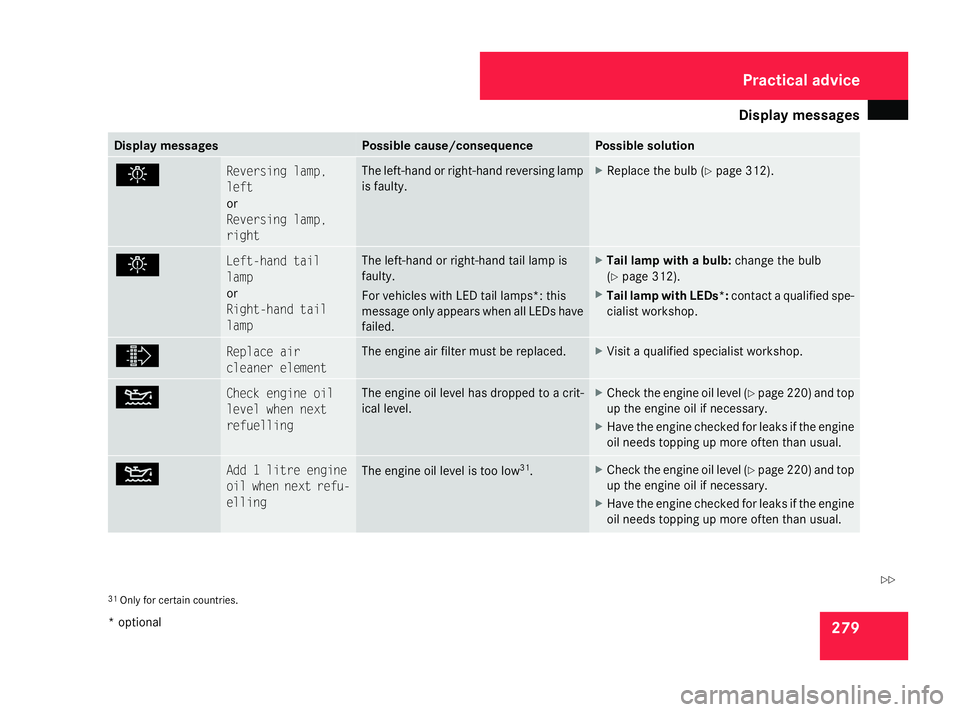
Display
messages 279Display messages Possible cause/consequence Possible solution
. Reversing lamp,
left
or
Reversing lamp,
right The left-hand or right-hand reversing lamp
is faulty. X
Replace the bulb (Y page 312). . Left-hand tail
lamp
or
Right-hand tail
lamp The left-hand or right-hand tail lamp is
faulty.
For vehicles with LED tail lamps*: this
message only appears when all LEDs have
failed. X
Tail lamp with a bulb: change the bulb
(Y page 312).
X Tail lamp with LEDs*: contact a qualified spe-
cialist workshop. ò Replace air
cleaner element The engine air filter must be replaced. X
Visit a qualified specialist workshop. N Check engine oil
level when next
refuelling The engine oil level has dropped to a crit-
ical level. X
Check the engine oil level (Y page 220) and top
up the engine oil if necessary.
X Have the engine checked for leaks if the engine
oil needs topping up more often than usual. N Add 1 litre engine
oil when next refu-
elling The engine oil level is too low
31
. X
Check the engine oil level (Y page 220) and top
up the engine oil if necessary.
X Have the engine checked for leaks if the engine
oil needs topping up more often than usual. 31
Only for certain countries. Practical advi
ce
* optional
164_AKB; 5; 5, en-GB
wobuchh,
Version: 2.10.6 2008-05-11T11:55:12+02:00 - Seite 279 ZDateiname: 6515_4293_02_buchblock.pdf; preflight
Page 283 of 381
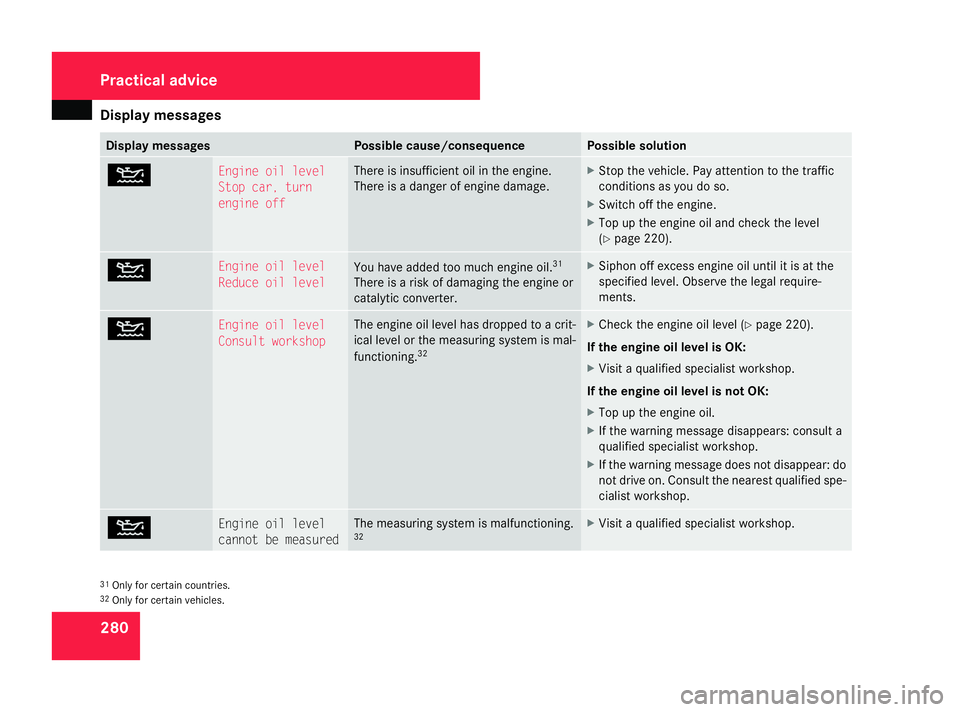
Display
messages 280 Display messages Possible cause/consequence Possible solution
N Engine oil level
Stop car, turn
engine off There is insufficient oil in the engine.
There is a danger of engine damage. X
Stop the vehicle. Pay attention to the traffic
conditions as you do so.
X Switch off the engine.
X Top up the engine oil and check the level
(Y page 220). N Engine oil level
Reduce oil level
You have added too much engine oil.
31
There is a risk of damaging the engine or
catalytic converter. X
Siphon off excess engine oil until it is at the
specified level. Observe the legal require-
ments. N Engine oil level
Consult workshop The engine oil level has dropped to a crit-
ical level or the measuring system is mal-
functioning.
32 X
Check the engine oil level (Y page 220).
If the engine oil level is OK:
X Visit a qualified specialist workshop.
If the engine oil level is not OK:
X Top up the engine oil.
X If the warning message disappears: consult a
qualified specialist workshop.
X If the warning message does not disappear: do
not drive on. Consult the nearest qualified spe-
cialist workshop. N Engine oil level
cannot be measured The measuring system is malfunctioning.
32 X
Visit a qualified specialist workshop. 31
Only for certain countries.
32 Only for certain vehicles. Practical advi
ce
164_AKB; 5; 5, en-GB
wobuchh,
Version: 2.10.6 2008-05-11T11:55:12+02:00 - Seite 280Dateiname: 6515_4293_02_buchblock.pdf; preflight